Super-Absorbing Polymer Powder
Sodium polyacrylate is an example of a super-absorbing polymer. It is a cross-linked (network) polymer that contains sodium atoms. It absorbs water by a process called osmosis. When the (sodium-containing) polymer is placed in contact with water, there is a tendency for the sodium to distribute equally between the network and the water. That means, some of the sodium atoms want to leave the network and move to the water. When these sodium atoms leave, they are replaced with water molecules. Water swells the polymer network to try to keep the sodium concentration balanced between the polymer and the water. The cross-links that connect the chains together prevent them from dissolving/breaking apart in the water. Sodium polyacrylate can absorb 800 times its weight in distilled water, but only 300 times its weight in tap water, since tap water contains some sodium, calcium and other mineral salts.
The experiment below will illustrate this phenomenon.
Supplies needed:
- Sodium Polyacrylate powder (available from Flinn Scientific Inc.)
- PolySnow™ powder (available from Flinn Scientific Inc.)
- 2 - 10 oz clear plastic cups
- Distilled water
- Squeeze bottles or containers of known volume
- Salt
Procedure:
1. Place 1/8 teaspoon of sodium polyacrylate powder in a plastic cup
2. Place 1/4 teaspoon of PolySnow™ in another cup.
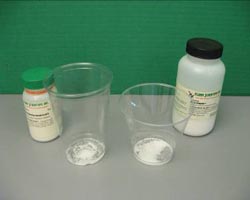
3. Using a 4 oz. squeeze bottle, slowly add distilled water to each of the powders, stirring gently; letting each powder absorb the water before adding more.
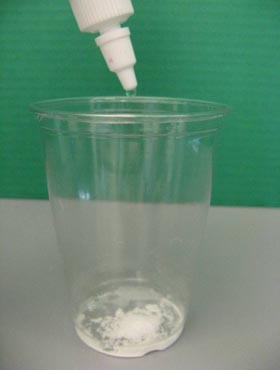
4. Continue adding water to both cups until absorption seems to stop.
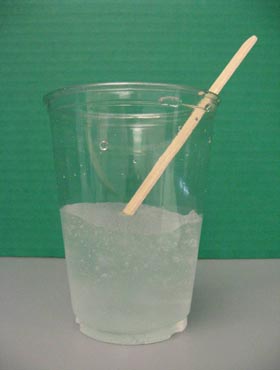
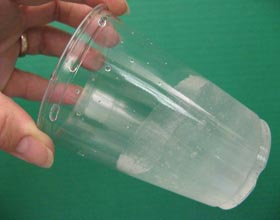
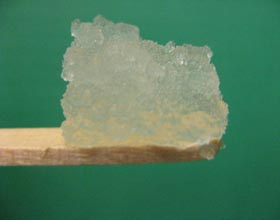
Observations:
- Gently touch the polymers in the cups. What do they look and feel like?
- Are they a solid or a liquid?
- How does PolySnow™ differ in appearance from the sodium polyacrylate?
- Does PolySnow™ absorb as much water as the sodium polyacrylate?
- Add a teaspoon of table salt (NaCl) or calcium chloride to both the swollen polymers. Observe what happens?
- Did the addition of salt have the same effect on the PolySnow™ as with the sodium polyacrylate?
Super-absorber Power Calculations:
In the case of the sodium polyacrylate, 1/8 teaspoon of the powdered polymer weighs 0.35 grams; 4 oz. of water weigh 120 grams. How many times its own weight in water did the polymer absorb?
Answer: 120g/0.35g=342.86 or approximately 343 times its weight!
Sodium polyacrylate and PolySnow™ are both forms of the same material and are both examples of super-absorbing polymers. The amount of cross-linking, called the crosslink density, determines the properties of the super absorber. Sodium polyacrylate and PolySnow™ differ in the amount of cross-linking. Sodium polyacrylate has fewer cross-links, and therefore can absorb more water than the PolySnow™. PolySnow™ gets its name from the fact that, within a certain concentration range, it absorbs water to form not the usual gel, but white particles that resemble snowflakes.
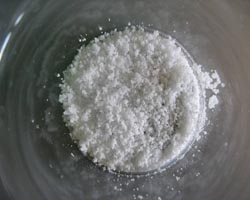
Sodium polyacrylate is the main ingredient in baby diapers used to "keep baby dry". It can absorb about 30 times its own weight in urine. An extension of this experiment involves taking a baby diaper apart to determine which part of the diaper "keeps baby dry".
Addition of salts of sodium or calcium reverses the swelling process. Water is no longer needed inside the polymer to balance the salt concentration, so the structure collapses or deflates.
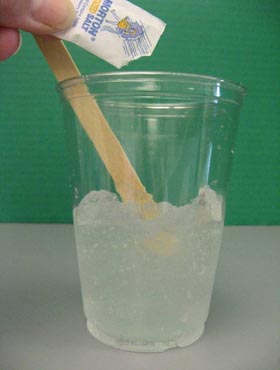
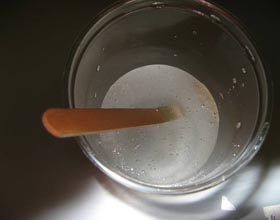
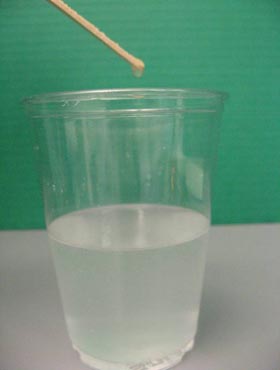
SAFETY NOTE:
Polyacrylate is non-toxic. It is, however, irritating to the eye and nasal membranes. Always wear chemical splash goggles when using this material. The gelled material can be disposed of in the trash. Do not put it in the sink, as it may clog the drain!